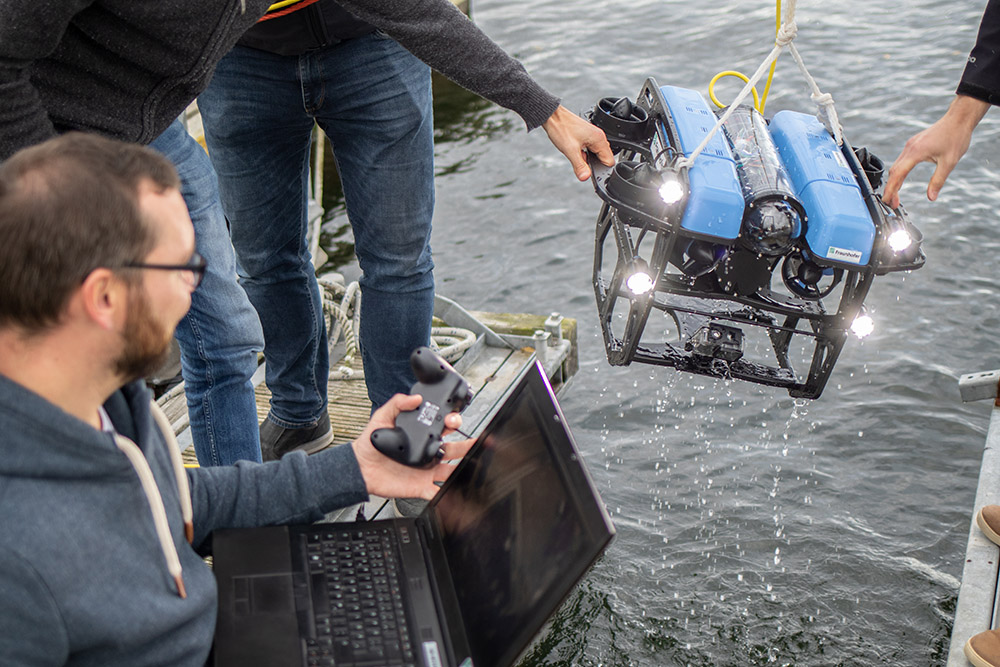New Fraunhofer research group develops methods for analyzing and filtering microplastics from the ocean
A new Fraunhofer-Gesellschaft research group at the Baltic Sea is developing underwater applications for more sustainable use of the ocean by humans. In their first project, researchers are exploring the issue of microplastics in the ocean.

A multidisciplinary research group with members from four Fraunhofer institutes recently began work at the OTC basecamp located at the Rostock Fishing Port in a further step toward developing the “Ocean Technology Campus Rostock” (OTC), whose vision is supported and driven by the Fraunhofer-Gesellschaft together with numerous partners. The goal of many local, regional, and national stakeholders is to establish the Hanseatic city as a leading locale for underwater technology research through the close interlinking of science and industry. In the new “Smart Ocean Technologies” research group, experts from the fields of IT, materials science, engineering, electronics, systems engineering, and sensor, energy, and automation technology are working together to create complex systems solutions for underwater applications. With the combined expertise of the Fraunhofer institutes IGD, IGP, IOSB, and IKTS, the group is researching embedded sensor and systems integration, the interlinking of computer vision, data mining, and machine learning methods, the testing of novel analytical methods, and the development of autonomous systems.
Turning the tide on microplastics
The group’s first project is analyzing plastic waste in the ocean with the goal of efficiently obtaining evidence on concentration and distribution—only then can the fight against ocean pollution be won. The goal of the project is to develop an expandable, automated technology platform for use on underwater vehicles. This platform can have different sensors added to it that will allow it to analyze in situ organic and inorganic pollutants in seawater.
Analysis and filtration in a single step
At present, the analytical process is extremely time-consuming and consists of multiple steps. After samples are taken, plastic particles are elaborately filtered out using laboratory methods to calculate their concentration. The samples themselves are currently taken predominantly from the ocean surface. The Fraunhofer solution seeks to remedy both of these issues: An optical particle sensor will detect the plastic particles, with the images being automatically analyzed on the spot with the help of deep learning methods. The system will be mounted on an underwater vehicle that will not only traverse different areas and depths but also be capable of in-situ filtration and extraction using a new measuring method. This is the vision of the young research group, though the current team of 10 still has their work cut out for them. One challenge, for example, is the aging process of and resulting material changes in the plastic particles—some of them microscopic—floating around in the ocean. The sensor in question would have to be trained to detect microplastics in any condition, regardless of how long they have been in the ocean.
Real testing possibilities in the Baltic Sea
The planned underwater testing ground off the coast of Nienhagen, the “Digital Ocean Lab” (DOL), will come in handy when developing and testing solutions. Still in the approval phase, the DOL will eventually be available for in-situ testing—that is, underwater testing of new technology under real conditions. Testing in a real environment will be a first and an important aspect of the success of the research group’s developments. At the same time, the group’s initial work will provide valuable input on the ongoing design of the underwater testing ground and play a conceptual role in its continued development. This versatile offshore underwater testing ground will, as the core of the OTC, be set up for different application scenarios, such as offshore wind, aquaculture, unexploded ordnance disposal, and many more. It will help both research and industry be able to test, evaluate, and optimize materials, modules, and entire underwater systems under controlled conditions in a real environment.
 Fraunhofer Institute for Computer Graphics Research IGD
Fraunhofer Institute for Computer Graphics Research IGD